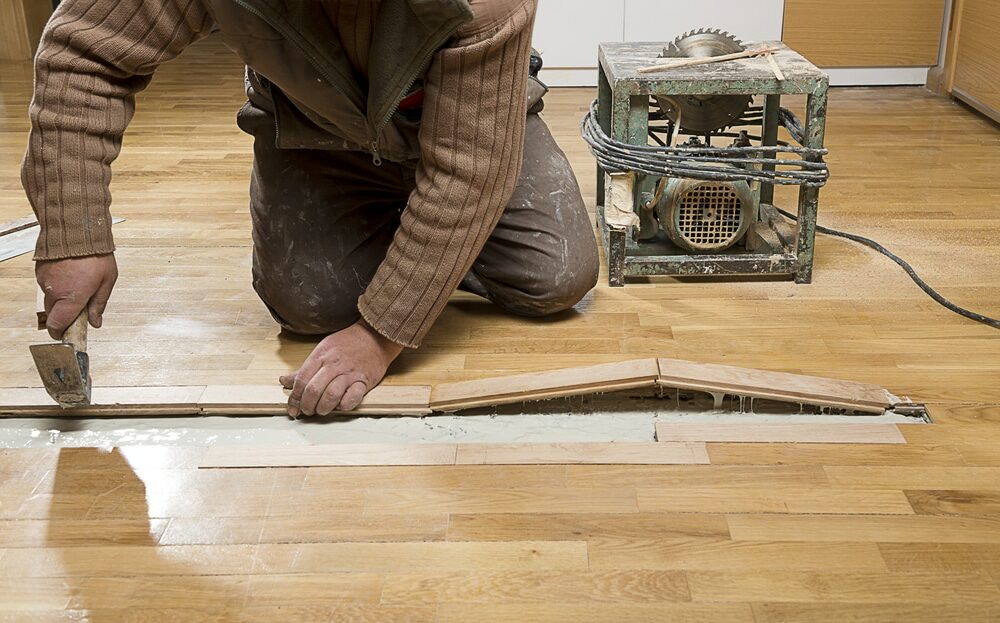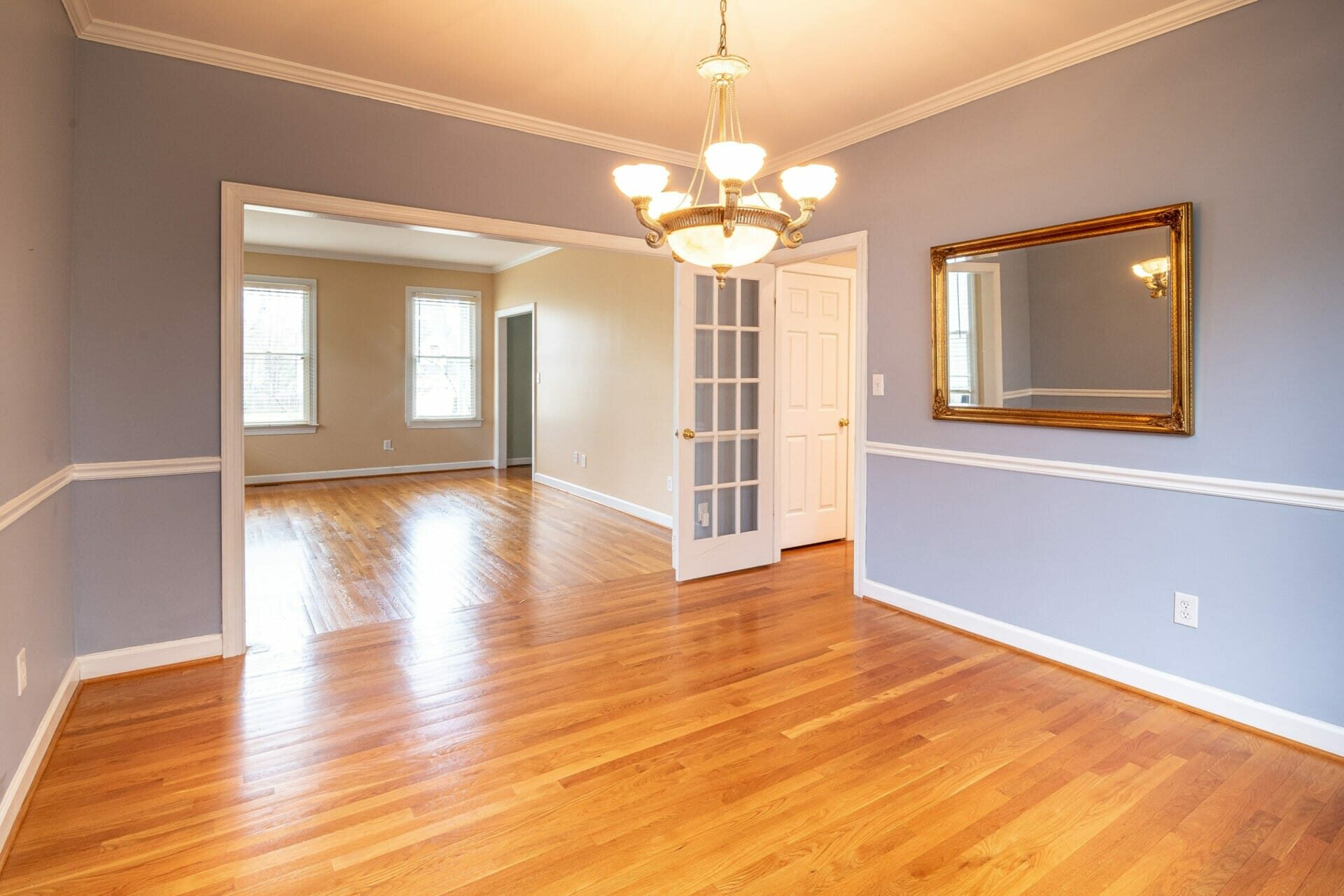London:
Nationwide:
Choosing the Best Coating for Your Wood Floors
Posted on December 7, 2023
Wood Floor Sealing & Varnishing Blogs
Selecting the Perfect Coating for Your Wood Floors: A Guide
Wooden floors add a touch of elegance and warmth to any home, making them a popular choice among homeowners. However, to keep your wood floors looking their best and to protect them from daily wear and tear, it’s crucial to choose the right coating.
Sealing Wooden floors bring an enduring sense of warmth and charm to any living space, serving as a timeless investment in your home’s aesthetics. However, their enduring beauty is often reliant on choosing the perfect coating that not only enhances their appearance but also provides protection against the rigors of daily life. In this comprehensive guide, we embark on a journey to help you navigate the intricate world of wood floor coatings. Whether you’re renovating existing floors or installing new ones, our exploration of coating types, assessment methods, durability considerations, sheen levels, eco-friendly choices, application techniques, cost factors, and popular brands and products will empower you to make an educated decision. Let’s embark on this quest together to ensure that your wood floors remain a source of pride, elegance, and comfort in your home for years to come.
In this comprehensive guide, we’ll walk you through the process of selecting the best coating for your wood floors. Whether you’re refinishing existing floors or installing new ones, understanding the different types of coatings, factors to consider, and the importance of durability and Wood Floor Maintenance will help you make an informed decision. Let’s dive in and ensure your wood floors remain a beautiful and durable asset to your home.
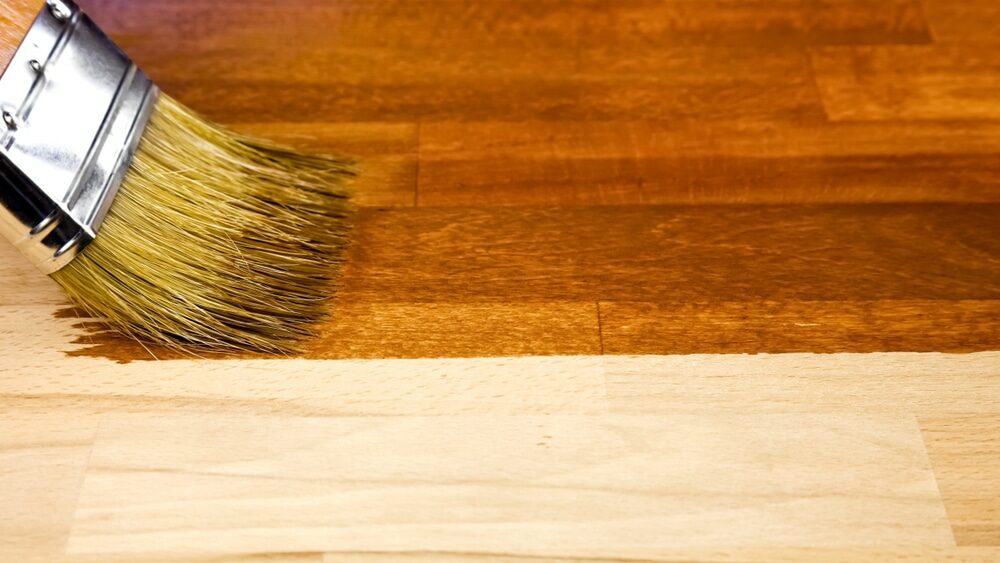
Types of Wood Floor Coatings:
When it comes to coating your wood floors, you’ll encounter several options, each with its own unique characteristics and advantages. Understanding these types of coatings is crucial to making the right choice for your specific needs. Here are the most common types:
1. Polyurethane:
- Polyurethane is one of the most popular wood floor coatings due to its exceptional durability and protection.
- Available in both water-based and oil-based formulations.
- Water-based polyurethane dries faster, has a lower odor, and is less toxic.
- Oil-based polyurethane tends to give wood floors a warm, amber hue and requires longer drying times.
2. Oil-Based Finishes:
- Oil-based finishes penetrate the wood, enhancing its natural beauty.
- They provide a warm, amber glow and are known for their depth and richness.
- Oil-based finishes take longer to dry but are highly durable and offer excellent protection.
3. Water-Based Finishes:
- Water-based finishes are known for their quick drying times and low odor.
- They maintain the wood’s natural color, offering a clear and contemporary look.
- While they may not be as durable as oil-based options, they are environmentally friendly and easy to work with.
4. Wax:
- Wax coatings provide a matte, low-sheen finish and a traditional, rustic appearance.
- They are easy to apply but require frequent maintenance and reapplication.
- Wax coatings may not offer as much protection against moisture and wear as other options.
5. Penetrating Oil:
- Penetrating oils soak into the wood, enhancing its grain and texture.
- They provide a natural, matte finish and are easy to spot-repair.
- These coatings may require more frequent reapplications compared to other options.
Choosing the right type of wood floor coating depends on various factors, including your wood species, desired aesthetics, and maintenance preferences. In the following sections, we’ll delve deeper into these considerations to help you make an informed decision for your wood floors.
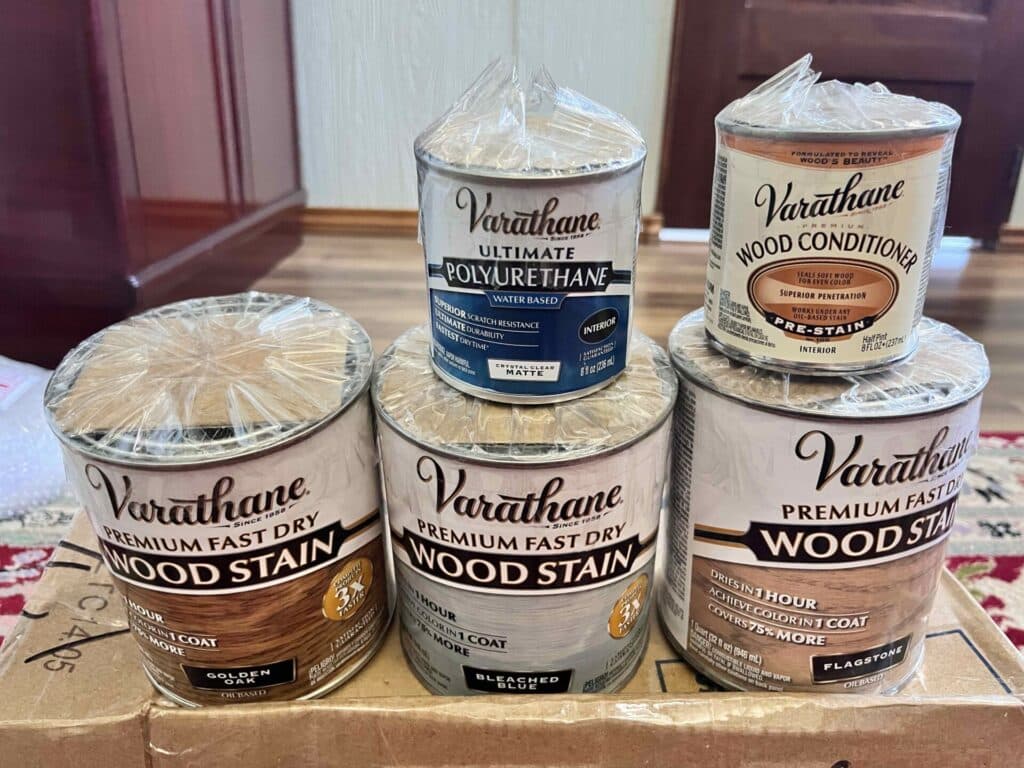
Assessing Your Wood Floors:
Before choosing the best coating for your wood floors, it’s essential to assess their current condition and understand various factors that can impact your coating selection. Here are some key aspects to consider when evaluating your wood floors:
1. Wood Species:
- Different wood species have varying hardness and grain patterns.
- Some species, like oak and maple, are harder and more resistant to wear, while others, like pine, are softer.
- Consider the type of wood your floors are made of, as it can affect how different coatings adhere and perform.
2. Current Finish:
- Determine the existing finish on your wood floors, if any.
- If you’re refinishing, identify whether the current finish is oil-based or water-based, as this can affect compatibility with the new coating.
- Sanding may be required to remove the old finish and prepare the surface for a new coating.
3. Foot Traffic:
- Assess the level of foot traffic in the area where the wood floors are installed.
- High-traffic areas, like hallways and living rooms, may require a more durable and wear-resistant coating.
- Consider the lifestyle of your household and the potential for pets or children causing additional wear and tear.
4. Aesthetic Preferences:
- Determine the desired look and finish for your wood floors.
- Some coatings, like oil-based finishes, add warmth and depth with an amber hue, while others, like water-based finishes, maintain a clear, contemporary appearance.
- Decide if you prefer a glossy, semi-gloss, satin, or matte finish.
5. Wood Floor Condition:
- Examine the condition of your wood floors for any imperfections, such as scratches, dents, or gouges.
- Note any areas with water damage or stains that may require special attention during refinishing.
- Consider whether you want to maintain or change the natural color of the wood.
6. Budget and Time Constraints:
- Assess your budget for wood floor coating, as different types vary in cost.
- Keep in mind that some coatings, like oil-based polyurethane, may require longer drying times between coats, impacting project timelines.
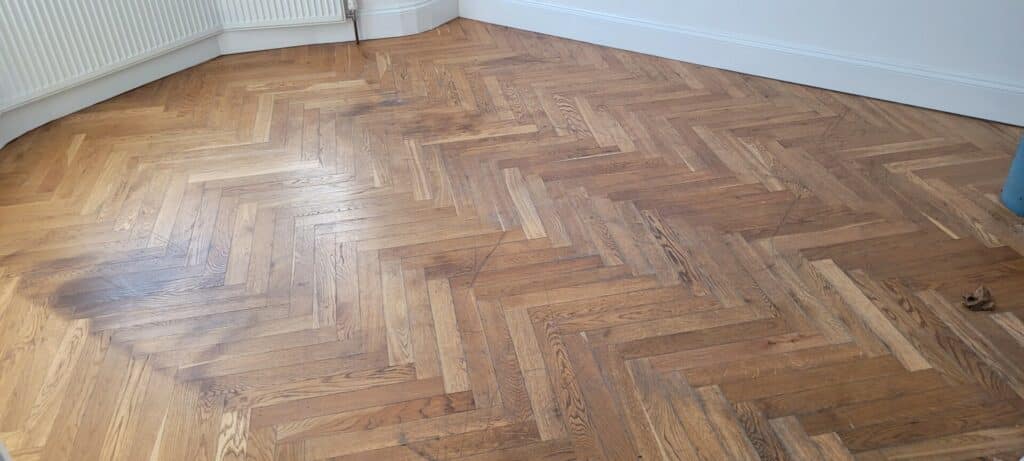
Durability and Maintenance:
When choosing a coating for your wood floors, durability and maintenance requirements are critical factors to consider. Here’s what you need to know:
1. Understanding Wear Resistance:
- The durability of your wood floor coating is crucial, especially in high-traffic areas. Different coatings offer varying levels of wear resistance.
- Polyurethane, both oil-based and water-based, is known for its excellent wear resistance and durability. It forms a protective layer on the surface of the wood, making it resistant to scratches and abrasions.
- Oil-based finishes tend to be more durable than water-based ones, but they may take longer to cure.
2. Maintenance Requirements:
- Regular maintenance is essential to keep your wood floors looking their best over time.
- Water-based finishes are typically easier to maintain as they require less frequent recoating and are less susceptible to yellowing. They also have a shorter drying time.
- Oil-based finishes, while durable, may need more extensive maintenance due to their longer curing time and potential for yellowing over time.
- Wax coatings can be high-maintenance, requiring frequent reapplication and buffing to maintain their appearance.
3. Cleaning and Care:
- Proper cleaning methods are essential for maintaining wood floors. Use a soft broom or vacuum with a soft brush attachment to remove dust and debris regularly.
- Avoid using excessive water when cleaning, as moisture can damage wood. Use a damp (not wet) mop with a wood floor cleaner recommended for your specific coating type.
- Wipe up spills promptly to prevent staining and water damage.
4. Recoating and Refinishing:
- Eventually, all wood floor coatings will show signs of wear and may require recoating or refinishing.
- Water-based finishes often require less sanding and preparation when recoating, making the process more straightforward.
- Oil-based finishes may need more extensive sanding and preparation during refinishing.
5. Lifestyle Considerations:
- Consider your lifestyle and how it may impact maintenance. For households with pets or young children, a more durable and low-maintenance coating may be preferable.
6. Long-Term Considerations:
- Think about the long-term cost of maintenance when selecting a coating. While some coatings may have a higher upfront cost, they may require less frequent refinishing, ultimately saving you money in the long run.
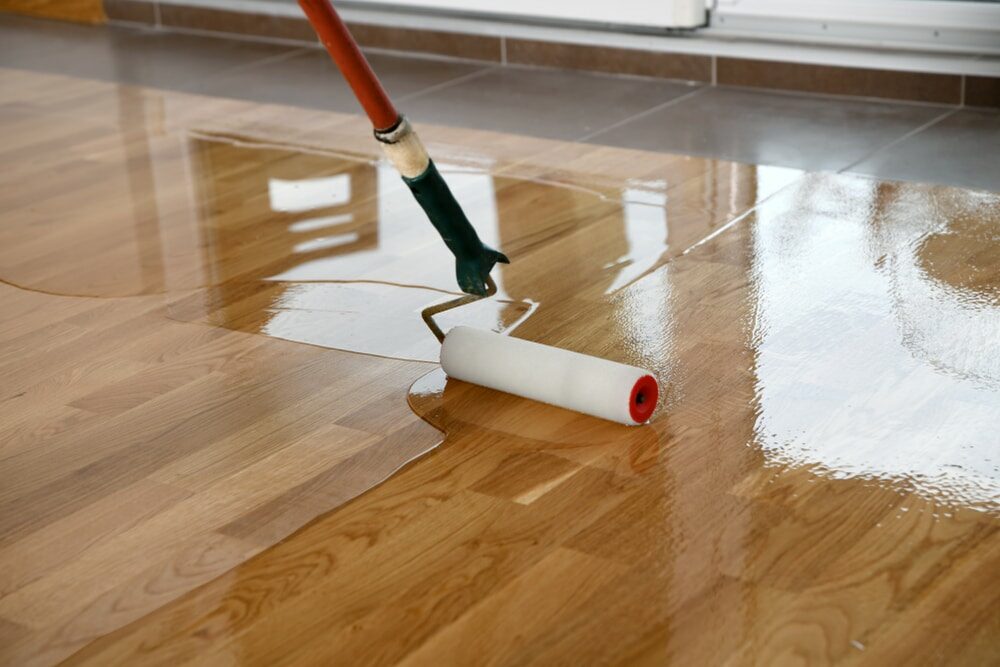
Finish Sheen Levels:
The sheen level of your wood floor coating plays a crucial role in the overall appearance and maintenance of your floors. Different sheen levels offer varying levels of shine and reflectivity. Here are the common finish sheen levels to consider:
1. Glossy Finish:
- A glossy finish provides the highest level of shine and reflectivity.
- It creates a polished and elegant look, making your floors appear shiny and reflective.
- While it offers a luxurious appearance, it can also show scratches and imperfections more easily than lower sheen levels.
- Glossy finishes are often used in formal or commercial spaces.
2. Semi-Gloss Finish:
- Semi-gloss finishes strike a balance between shine and durability.
- They offer a moderate level of shine and are easier to maintain than a high-gloss finish.
- Semi-gloss coatings are a popular choice for many residential applications, including living rooms and bedrooms.
3. Satin Finish:
- Satin finishes have a soft sheen that provides a subtle, smooth appearance.
- They offer a level of shine that enhances the wood’s natural beauty while hiding minor imperfections.
- Satin finishes are versatile and work well in various settings, from traditional to contemporary.
4. Matte Finish:
- Matte finishes have the lowest level of shine, appearing nearly flat.
- They provide a natural and rustic appearance, making them suitable for casual and traditional spaces.
- Matte finishes are excellent at hiding scratches and scuffs, making maintenance less demanding.
Choosing the right sheen level for your wood floor coating depends on your personal preferences and the intended use of the space. Here are some considerations:
- High-Traffic Areas: For areas with heavy foot traffic and the potential for more wear and tear, a satin or semi-gloss finish is often recommended. These sheen levels strike a balance between durability and aesthetics.
- Formal Spaces: If you’re aiming for a formal and elegant look, a glossy finish can create a sophisticated atmosphere. Just keep in mind that it may require more maintenance to keep it looking its best.
- Casual and Family-Friendly Spaces: In homes with children and pets, or for a more relaxed and rustic feel, a matte finish is an excellent choice. It hides imperfections and is forgiving when it comes to minor scratches.
- Personal Aesthetics: Your personal preferences play a significant role in choosing the right skin tone. Consider what appeals to you and complements the overall design of your home.
Ultimately, the sheen level you select will impact the appearance, maintenance, and ambiance of your wood floors, so choose the one that best aligns with your vision and lifestyle.
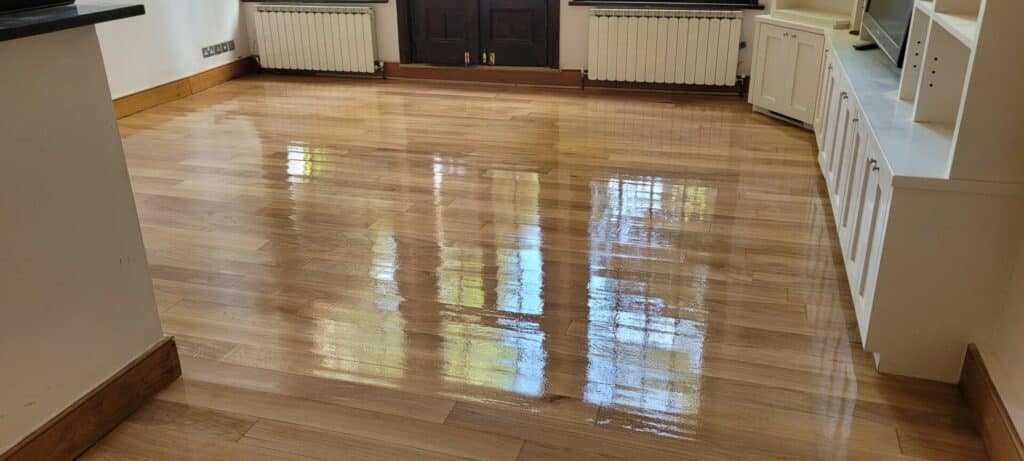
Environmental Considerations:
In today’s environmentally conscious world, choosing an eco-friendly wood floor coating is not only a responsible choice but also one that can benefit your indoor air quality and the planet. Here are some key environmental considerations when selecting a wood floor coating:
1. VOC Content:
- Volatile organic compounds (VOCs) are chemicals that can vaporize into the air and contribute to indoor air pollution.
- Many traditional wood floor coatings, especially oil-based ones, can contain high levels of VOCs, which can negatively impact air quality and health.
- Consider low-VOC or zero-VOC coatings, which release fewer harmful chemicals into the air during application and drying.
- Water-based finishes generally have a lower VOC content compared to oil-based ones and are often a more environmentally friendly choice.
2. Eco-Friendly Options:
- Look for wood floor coatings that are labeled as eco-friendly, sustainable, or environmentally responsible.
- Some coatings are made with renewable resources and have minimal environmental impact during production and disposal.
- Products certified by third-party organizations like Green Seal or the Forest Stewardship Council (FSC) are good indicators of eco-friendly choices.
3. Recyclability and Disposal:
- Consider the recyclability and disposal of the coating materials.
- Eco-friendly coatings are often designed to be more easily recyclable or biodegradable, reducing their environmental footprint.
4. Longevity and Maintenance:
- Choose a coating that has a longer lifespan and requires less frequent refinishing, as this can reduce the overall environmental impact.
- Wood floor coatings that need frequent replacement generate more waste and consume additional resources.
5. Local Sourcing and Manufacturing:
- Whenever possible, opt for coatings that are locally sourced or manufactured. This can help reduce the carbon footprint associated with transportation.
6. Energy Efficiency:
- Consider the energy efficiency of the coating application process. Some coatings require less energy for drying or curing, which can contribute to a smaller environmental footprint.
7. Sustainability of the Wood:
- In addition to the coating, evaluate the sustainability of the wood itself. Look for wood that is sourced from responsibly managed forests or reclaimed sources.
8. Certifications and Labels:
- Check for certifications and labels that indicate a commitment to sustainability and environmental responsibility, such as the Greenguard certification.
Application Methods:
The way you apply your chosen wood floor coating is crucial to achieving the desired finish and durability. Whether you’re planning to do it yourself or hire a professional, understanding the application methods is essential. Here are some key considerations:
1. DIY vs. Professional Installation:
- Decide whether you want to apply the coating yourself (DIY) or hire a professional flooring contractor.
- DIY can save you money, but it requires careful preparation, attention to detail, and the right tools.
- Professional installation ensures a high-quality finish, especially for complex projects or when working with challenging coatings.
2. Proper Preparation:
- Before applying any coating, thorough preparation of the wood surface is essential.
- Sanding: Sand the wood to create a smooth, clean surface for the coating to adhere to. Use progressively finer grits for a polished result.
- Cleaning: Remove all dust, dirt, and debris from the floor to ensure a flawless finish.
- Patching and Repairs: Address any imperfections, cracks, or holes in the wood before applying the coating.
3. Application Techniques:
- The application technique can vary depending on the type of coating you choose. Here are some general guidelines:
4. Brushing and rolling:
- Brushes and rollers are commonly used for water-based and oil-based polyurethane coatings.
- Apply the coating in thin, even coats, following the wood grain.
- Use a high-quality brush or roller to avoid streaks and bubbles.
5. Spraying:
- Spraying is often used for water-based coatings to achieve a smooth, even finish.
- It requires specialized equipment, so it’s typically done by professionals.
- Proper ventilation is essential when spraying to ensure even coverage and prevent over-application.
6. Waxing:
- For wax coatings, apply the wax using a clean, lint-free cloth.
- Allow the wax to dry, and then buff it to achieve the desired level of shine.
- Repeat the waxing process as needed to maintain the finish.
7. Penetrating Oils:
- Penetrating oils are usually applied by brushing or wiping onto the wood.
- Ensure even coverage, and allow the oil to soak into the wood.
- Remove any excess oil to prevent a sticky finish.
8. Drying and Curing Times:
- Pay attention to the recommended drying and curing times for your chosen coating.
- Proper drying and curing are critical for achieving the desired finish and durability.
- Avoid walking on or placing furniture on freshly coated floors until they are fully cured.
9. Ventilation and Safety:
- Ensure proper ventilation when applying coatings, especially those with higher VOC levels.
- Use appropriate safety equipment, such as masks and goggles, to protect yourself during the application.
10. Clean-Up:
- Clean your tools and equipment immediately after use, following the manufacturer’s recommendations.
- Proper disposal of used materials and containers is essential, especially when dealing with coatings that contain chemicals.
The application method you choose should align with your skill level and the specific requirements of your project. Whether you decide to DIY or hire a professional, following proper preparation and application techniques will help you achieve a beautiful and long-lasting wood floor finish.
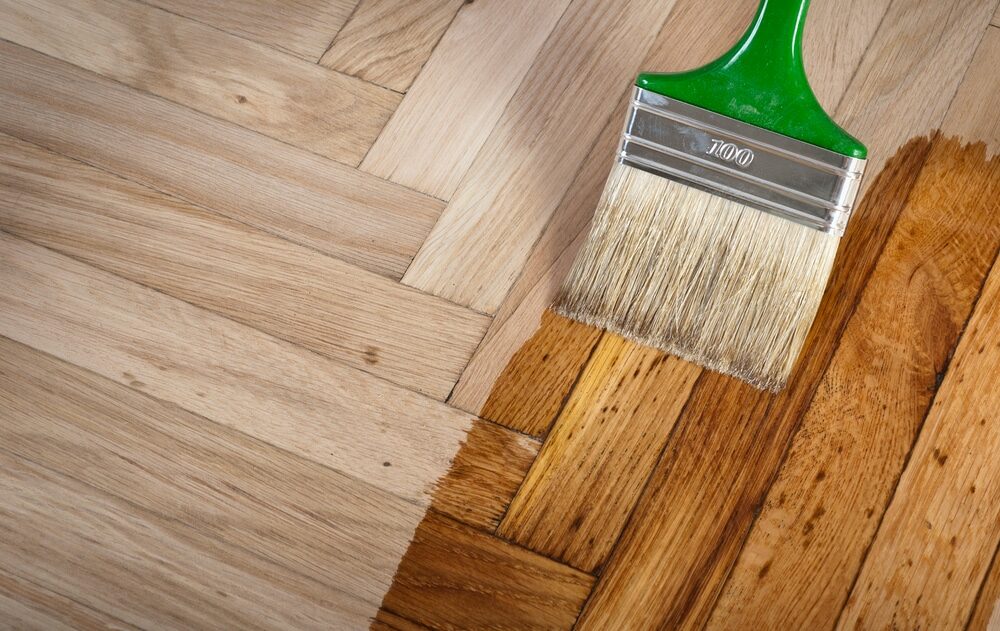
Cost Considerations:
When selecting a wood floor coating, it’s essential to factor in both the initial costs and the long-term savings associated with your choice. Here’s what to consider:
1. Initial Costs:
- Different types of wood floor coatings come with varying price tags.
- Oil-based polyurethane coatings, for example, are often more affordable upfront but may require more coats and have longer drying times.
- Water-based polyurethane coatings can be slightly more expensive, but they dry faster and have lower VOC levels.
- High-gloss and semi-gloss finishes may cost more than matte or satin finishes due to their additional sheen.
2. Coverage Area:
- Calculate the square footage of the area you plan to coat to determine how much coating you’ll need.
- Keep in mind that some coatings may require more coats for proper coverage, potentially increasing the cost.
3. Labor Costs:
- If you decide to hire a professional to apply the coating, labor costs will be an additional expense.
- Professional installation can ensure a high-quality finish and may be worth the investment, especially for complex projects.
4. Long-Term Savings:
- Consider the long-term savings associated with your choice of coating.
- Coatings that require less frequent refinishing or touch-ups can save you money over time.
- Low-maintenance coatings may also reduce the need for costly repairs and replacements.
5. Maintenance Costs:
- Think about the ongoing maintenance costs associated with your chosen coating.
- Some coatings, like wax, may require more frequent reapplication and maintenance, which can add up over the years.
- Water-based finishes often require less frequent recoating and may save you money on maintenance.
6. Environmental Impact:
- While it is not directly related to cost, consider the potential environmental impact of your coating choice.
- Eco-friendly coatings may have a slightly higher initial cost but can contribute to a healthier indoor environment and reduce long-term health expenses.
7. Return on Investment (ROI):
- Think about the resale value of your property. A high-quality wood floor coating can enhance the appeal of your home and potentially increase its value.
8. Budget Flexibility:
- Determine your budget for the project and be flexible when necessary. Investing in a higher-quality coating upfront can lead to cost savings in the long run.
9. Comparing Brands and Products:
- Compare the prices and features of different brands and products within the same coating category.
- Read reviews and seek recommendations to find a cost-effective option that meets your needs.
10. Warranty and Guarantees:
- Some coatings come with warranties that cover specific issues, such as peeling, chipping, or fading. Consider the value of the warranty when assessing costs.
Ultimately, the choice of wood floor coating should align with your budget and long-term goals. By weighing the initial costs against potential savings and benefits, you can make an informed decision that suits both your financial situation and your desired outcome for your wood floors.
Conclusion:
Choosing the best coating for your wood floors is a decision that can significantly impact the beauty, durability, and longevity of your investment. In this comprehensive guide, we’ve explored various aspects to consider when making this important choice. Here’s a recap of the key points:
- Types of Wood Floor Coatings: We discussed popular options such as polyurethane, oil-based finishes, water-based finishes, wax, and penetrating oils, each with its unique characteristics.
- Assessing Your Wood Floors: Understanding your wood species, current finish, foot traffic, aesthetic preferences, and overall condition helps you make an informed decision.
- Durability and Maintenance: We emphasized the importance of choosing a coating that aligns with your maintenance preferences and long-term savings goals.
- Finish Sheen Levels: The level of sheen you choose impacts the appearance and maintenance of your wood floors, so select one that complements your style and lifestyle.
- Environmental Considerations: Eco-friendly coatings with low VOC content and sustainable sourcing can contribute to a healthier indoor environment and a reduced carbon footprint.
- Application Methods: Whether you opt for DIY or professional installation, proper preparation and application techniques are crucial for achieving a successful finish.
- Cost Considerations: Weigh the initial costs, long-term savings, and maintenance expenses to choose a coating that fits your budget and goals.
In closing, selecting the best coating for your wood floors is a multifaceted decision that requires careful consideration of your unique circumstances and preferences. Remember that the right choice not only enhances the aesthetics of your home but also ensures that your wood floors stand the test of time.
By assessing your needs, conducting thorough research, and possibly consulting with flooring professionals, you can confidently choose a wood floor coating that meets your expectations and allows you to enjoy the natural beauty of your wood floors for years to come.

Sanding
We provide virtually dust-free sanding with our continuous belt machinery with mobile extraction units, giving you a safer environment for your family.
Oiling
This organic finish not only adds beauty to your home but also has exceptional water-repellent characteristics, making it easier to clean and maintain.
Waxing
This natural floor finish offers the softest and most mellow appearance – and leaves your floor able to breath.
Buffing
Using soft buffing machines (and hand-polishing where required) will bring a wonderful sheen to your newly-finished floor.
Repairs
We offer a full assessment of your wooden floors to determine what repairs are needed to provide the perfect working surface for the later stages of sanding, staining and sealing.
Restoration
We offer a comprehensive restoration process designed to address floors that are improperly fitted or damaged over time through wear and tear.
Request a fixed price quote for your wood floor restoration now
Simply enter your postcode below to get started.
Services
Wood Floor Sanding Wood Floor Restoration Wood Floor Scratch Repair Squeaky Wood Floor Repair Parquet Floor Sanding Parquet Floor Restoration Commercial Floor Sanding Church Floor Sanding Community Centre Floor Sanding School Floor Sanding Gap Filling Gap Filling with ResinCopyright © Mr Sander®
Privacy & Cookies Terms & Conditions Complaints Procedure Cancellation Rights Sitemap
